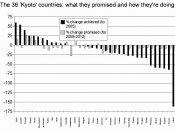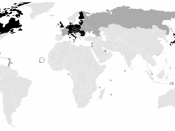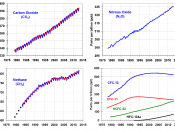It will be the destruction of earth. Global warming is increasing the average temperature of the earth's atmosphere and is changing regional climates. It is caused by greenhouse gases, weather, and part of the greenhouse effect. By 2100, it is predicted that the earth's average temperature will rise by 1.5úC to 4.5úC. The greenhouse effect keeps the earth 30úC warmer; it forms a layer around the atmosphere and because of greenhouse gases, infrared radiation from the sun heats the planet even more. The greenhouse gases include methane, carbon dioxide, nitrous oxide, ozone, and chlorofluorocarbons (CFCs). Methane emits 15 - 20% of the greenhouse gases. It is used agriculturally or in natural gas production. Carbon dioxide contributes to 60% of the greenhouse gases being emitted. Whenever fuel is burnt, it releases CO2 into the atmosphere. Nitrous oxide is created when agriculture is a main role of a country or region.
Air pollution produces ozone and refrigeration produces CFCs. Hence, global warming is negatively affecting Canada and the rest of the world and must be slowed down.
Global warming is going to drastically change the regions of Canada. British Colombia and the Yukon, the sea levels are going to rise and there will be more precipitation in the winter. Floods may occur in the spring with a possibility of droughts in the summer. These affects will be negative because they will flood homes and facilities on the coast, destroy fish habitats, and decrease tourism. Canada's Prairies will be affected with a higher frequency of droughts, along with lower soil moisture. This could either decrease crop harvests by 10 - 30% or it could increase the growing season. Greenhouse gas emissions could increase as well as more fossil fuels being produced. The Arctic's annual temperatures are likely to increase by...


